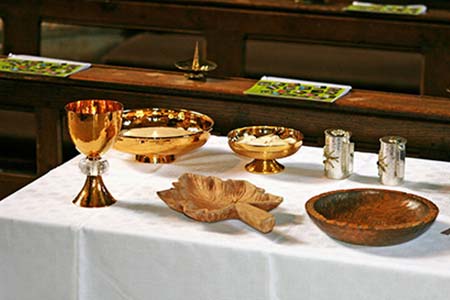 Acts 2:14, 22-33
Acts 2:14, 22-33
 1 Peter 1:17-21
1 Peter 1:17-21
 Luke 24:13-35
Luke 24:13-35
While the Judean town of Emmaus cannot be located with certainty, Luke's message in today's gospel reading is clear. Three distinct themes emerge from this dramatic episode with nuances and steps for a liturgical worship.
First, the interpretation of Scriptures. For Luke, interpreting Scriptures is as important as reading it. In the story, Jesus interprets Scriptures to the two disciples, “Was not our heart burning within us while he was speaking on the road and explaining to us the scriptures?” (Lk 24:32). He does the same to the eleven in Jerusalem when He appears to them (Lk 24:45). Philip is directed to explain to the Ethiopian eunuch who fails to understand the passage from Isaiah (Acts 8:26-36).
Second, the Breaking of the Bread. Inasmuch as Jesus is recognized in the Scripture, He is foremost recognized in the Eucharist (a term used by early Christian for the breaking of the bread) (Lk 24:31,35, CCC1373). The mystical overtone of the meal with the two disciples reminds us of the Lord's Last Supper with the apostles. Jesus' actions of taking the bread, giving thanks, breaking and giving it to the disciples bear a strong Eucharistic accent (rf CCC 1329).
Third, the sharing of the experience with others. Imagine, had the two disciples kept the incident to themselves and continued their way, they would not have known that Jesus also appears to Peter and would have missed the second encounter with Him (Lk 24:36). By sharing their story, they bear witness of Jesus' resurrection together with the other disciples.
Our liturgical celebration of the Eucharist follows the above structure of Jesus' Last Supper “which has been preserved throughout the centuries” (CCC1346).We know that Scriptures speak about Jesus and find fulfillment in Him (rf Lk 24:44). Through the reading of Scriptures, a portion of Jesus' life is relived. In the Liturgy, the sacred word is expounded, elucidated and applied during the homily that follows the readings. It is not so much a matter of historical knowledge but of faith building and penetration. In the Liturgy, the Eucharistic actions together with the Eucharistic Prayer of thanksgiving and consecration constitute the summit of our worship and celebration. Not only is this a memorial, but it is also a sacrifice that “re-presents (makes present) the sacrifice of the cross” (CCC1366). The Liturgy concludes with the sending forth (missio) of the faithful to the world with the same intention: to be witnesses of our faith, to let God's light shine through our lives and to transform the world around us.
From the beginning, the Eucharistic assembly of the faithful has stayed the same in its form and order “despite the great diversity of times and liturgies” (CCC1356). Let us remember that each time when we participate in the Liturgy, we are the two disciples whose experience on the road to Emmaus has been concretized and eternalized through the ministry of the Church.
